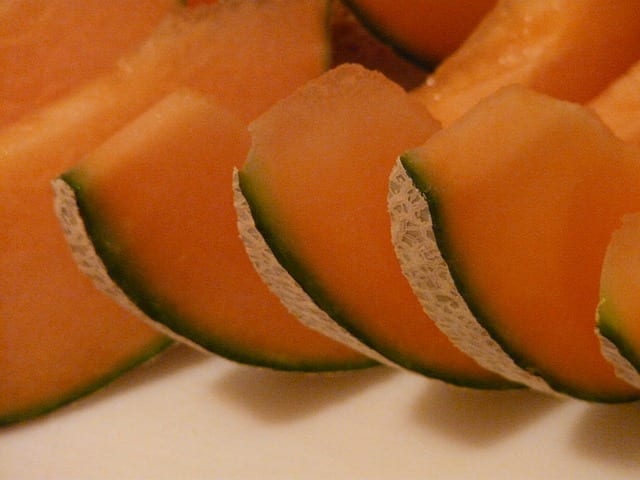It’s time! Melons can be planted in our San Antonio gardens now, hooray! Have you always wanted to plant a melon, but just didn’t have the information you needed to be successful? Well, it’s your lucky day today. We’re sharing some tips for growing melons in our area.
In order for cantaloupe to develop a desirable flavor, we must:
- Choose the recommended varieties for our area (Hales Best, Ambrosia)
- Have good soil prep (they tend to do best in sandy loam, and loose, silty soils).
- Ample watering is important at planting and early development, but when fruits are nearing maturity, make sure they don’t receive excess moisture. You’ll need to offer cantaloupes the following necessities to encourage them to grow to their fullest potential.


The basics needed for growing cantaloupes:
Timing:
Plant cantaloupes when the soil is warm, and nighttime temperatures remain above 55°F. In San Antonio the planting time for melons is generally March – April, with a harvest time from June – November.
Sunshine:
Offer cantaloupes an area in full sun. This means at least 6-8 hours of direct sunlight.
Space:
For growing just a couple cantaloupes, you need at least 6′ in all directions of the the plant or seeds. For larger gardens, with row planting, space rows 6′ apart with 18″ between plants. It’s recommended to plant cantaloupe in “hills”. This just means creating an elevated mound above the soil line to help assist with drainage.
Soil Depth:
At the least, a soil depth of 10-12″ is recommended, and deeper is even better (or plant in raised beds that are also helpful if your native soil is heavy and you struggle with good soil drainage). Remember the “hilling” mentioned above.
Soil Amendments:
The addition of rich, organic matter is always a good idea. Mix 2-3 inches of organic compost/soil conditioner into your native soil or raised beds. Try to mix it to a depth of 8-10″. This will help loosen up heavy soils, or improve droughty soils (soils that have the least levels of plant-available moisture) and help soil hold more moisture and essential nutrients.
Fertilizer:
A granular fertilizer mixed into the soil before planting is beneficial. We like Espoma Garden-Tone. Follow the label for specific product instructions on applications and rates based on your sized garden.
A liquid fertilizer that you can dilute and offer at planting time jumpstarts the growth of your cantaloupes. We like Medina Hasta Gro Plant, or FoxFarm Grow Big.
Finally, when cantaloupes begin to vine, offer a side dressing of nitrogen fertilizer. A second application of this fertilizer is recommended once the plants first start to set fruit. If you have leftover Rainbow Gardens 19-5-9 fertilizer from feeding your lawn, this would be a great use for it.
For small gardens with just a couple cantaloupes, apply fertilizer in a circle, around the plants, about 8″ away from them. You’ll probably only need about 2 Tbsp of fertilizer. For larger gardens, apply in a band along the side of the plants, using about ½ cup of fertilizer per 15 feet of row.
Gently scratch fertilizer into the soil and always water thoroughly right after applying.
Water:
You’ll need plenty of water at planting time and while cantaloupes are developing foliage and long, twining, vines. A good, deep, watering of 6″ each week is ideal (keep rainfall in mind). However, once cantaloupe fruits start to develop that netting pattern around their outsides, offer your plants only light, frequent waters. As mentioned before, when fruits are nearing maturity, make sure they don’t receive excess moisture.
Cantaloupe Pests
In May, pest activity always ramps up in San Antonio gardens. Cantaloupe will be susceptible to any pests or disease that affects other veggies and fruits in the cucurbit family (squash, cucumbers, pumpkins, gourds, other melons). These include: aphids, cucumber beetles, squash bugs, powdery mildew, and downy mildew.
Choose the least toxic pesticides and fungicides to control these problems because pollination is key for crop success. Applying general “wipe-out” sprays has the negative effect of also wiping out the pollinators. We can help you with pest and disease identification if you bring in pictures of damage to your plants, and pictures of the pests if you can get them.
Nestle a few plants around your melons and veggie gardens that attract beneficial insects and/or pollinators. Many times, the beneficial insects will do the work a pesticide would do, and the more pollinators you can attract, the better your vines will produce flowers and fruit.
Ready to give cantaloupes a try. Come on and take a look at those melons!
The Happy Gardener, Lisa Mulroy

